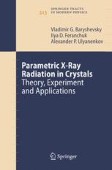Search
Search Results
-
Dynamical Theory of Parametric X-ray Radiation
Previous chapters demonstrate a close analogue between the theory of parametric X-ray radiation (PXR) in thin crystals and the kinematic theory of...
-
Towards a Rational Design of Molecular Switches and Sensors from their Basic Building Blocks
A fundamental understanding of the thermodynamics and kinetics of mechanically interlocked molecules, such as [2]rotaxanes, will contribute to...
-
Impedimetric Detection of DNA Hybridization: Towards Near-Patient DNA Diagnostics
Immobilization strategies for the attachment of nucleotide probes to both microarrays and microfabricated interdigitated electrodes differ to...
-
Radiation from a Charged Particle in Periodic Media: Classical Theory
The method of pseudophotons, considered in the previous chapter, is convenient for qualitative analysis of parametric X-ray radiation (PXR). PXR in...
-
Prospective Applications of PXR
The previous chapters concern the fundamental properties of PXR, which have been experimentally observed and theoretically explained. The most recent...
-
Electromagnetic Radiation from a Charged Particle in Crystals: Qualitative Consideration
Electromagnetic radiation caused by motion of a charged particle has been studied for more than 100 years. It was firmly believed for an appreciable...
-
Immobilization of DNA on Microarrays
Microarrays are new analytical devices that allow the parallel and simultaneous detection of thousands of target compounds. Microarrays, also...
-
Tin-Free Radical Reactions Mediated by Organoboron Compounds
The development of tin-free methods to run radical reactions is crucial for their applications in industrial processes as well as in drug...
-
The Degenerative Radical Transfer of Xanthates and Related Derivatives: An Unusually Powerful Tool for the Creation of Carbon–Carbon Bonds
This review summarises recent work on the dithiocarbonyl group transfer reaction. Xanthates, in particular, have proved to be extremely useful for...
-
Altitudinal Surface-Mounted Molecular Rotors
After a general description of some potential applications of artificial altitudinal surface-mounted molecular rotors, the synthesis, surface...
-
Immobilization of Nucleic Acids Using Biotin-Strept(avidin) Systems
There are several advantages for using biotin-streptavidin/avidin (strept(avi-din)) systems to immobilize nucleic acids and other molecules. These...
-
Immobilization of Oligonucleotides for Biochemical Sensing by Self-Assembled Monolayers: Thiol-Organic Bonding on Gold and Silanization on Silica Surfaces
The covalent immobilization of biomolecules on surfaces is of great interest for many medical and bioanalytical applications. Currently, there is...
-
Thio-, Seleno-, Telluro-Amides
Recent developments regarding synthetic methods of producing chalogen isologues of amides are reviewed. Among exhaustive studies on the syntheses,...
-
The Construction and Operation of Anion Sensors: Current Status and Future Perspectives
This chapter is intended to provide an insight into the construction and operation of anion sensing devices, rather than the chemistry of anion...
-
Evidences for Polaron Formation in Cuprates
It is widely believed that the essential physics of high temperature superconducting copper oxides are governed by the properties of their...
-
Phosphinidenes
Of the low-valent organophosphorus compounds phosphinidenes occupy a special place. In ‘free’ phosphinidenes the phosphorus atom carries a single...
-
Asymmetric Processes Catalyzed by Chiral (Salen)Metal Complexes
A wide variety of highly selective asymmetric reactions catalyzed by chiral (salen)metal complexes have been disclosed over the past decade. Salen...
-
Sparteine as a Chiral Ligand for Asymmetric Catalysis
While the use of stoichiometric amounts of sparteine and related ligands in various asymmetric reactions often lead to highly enantioselective...
-
The Zintl–Klemm Concept Applied to Cations in Oxides. II. The Structures of Silicates
The structures of ternary and quaternary silicates are revisited on the basis of the Zintl–Klemm concept and the Pearson's generalised octet rule....
-
Probing Hydrogen Bonding in Solids Using Solid State NMR Spectroscopy
Solid state nuclear magnetic resonance (NMR) spectroscopy is a powerful and versatile technique for probing structural and dynamic properties of...
